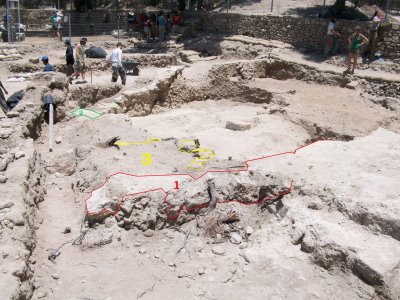
And, as on previous occasions, I'll recourse to drawing lines on a picture to show what we've been up to.
The area circled in red and labeled 1 is the line of plastered stones that we've been aware of since we got through the topsoil. It's looking slightly better defined now, because we've taken out some tree roots that were in the way, but it's basically the same as it's ever been.
 The bit circled in green, and labeled 2 is a tiny fragment of a floor, that had been around in the previous seasons, and which might continue underneath the bits we haven't excavated. But we did get a bit more of it, after taking out a rather strange pair of well plastered, rectangular stones that seemed to just sort of be standing by themselves, with no relationship to any other floor or surface.
The bit circled in green, and labeled 2 is a tiny fragment of a floor, that had been around in the previous seasons, and which might continue underneath the bits we haven't excavated. But we did get a bit more of it, after taking out a rather strange pair of well plastered, rectangular stones that seemed to just sort of be standing by themselves, with no relationship to any other floor or surface.
The bit labeled 3 is what's giving us the most cause for puzzled consideration. It seems to be bounded by a semi-circle of stones, which I've circled in yellow, but which remain hard to see in the picture, and judging by the bit of the crusader pit that we've dug, those stones do seem to go further down.
So, based on that, it looks like it should be a stone lined pit. The reason why I'm not jumping to that conclusion is that the material in the area marked 3 is not very different than the material to the north of it. And, generally speaking, when you get pits, you get something filling them.
So, we'll see what happens tomorrow -- My assumption is that this feature is going to be resolved, one way or another. Or at least we'll be able to make a guess, and work on that basis.
Also appearing in the picture, but not labeled, are supervisory staff, volunteers, hired workers, Garstang's wall, several other squares, a wheelbarrow, and a stick with a bucket on the end. See if you can identify which is which!
